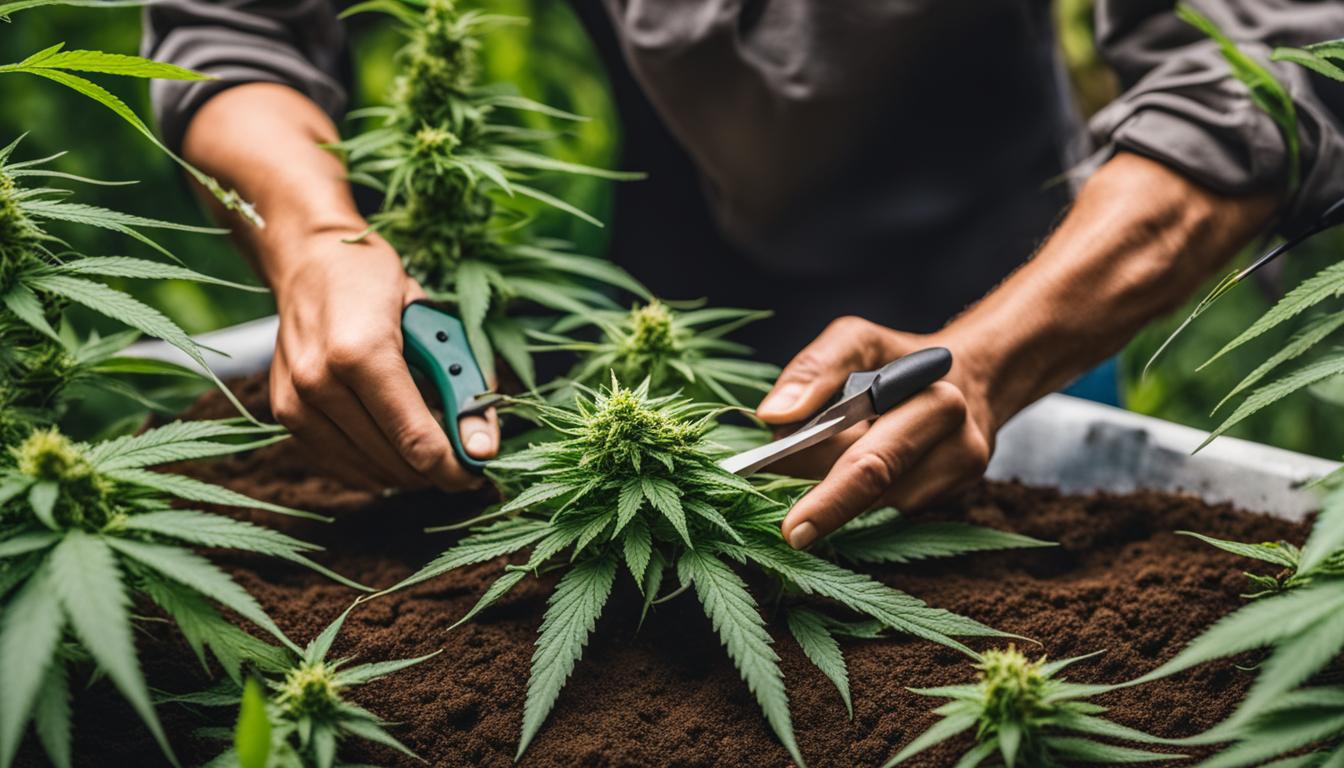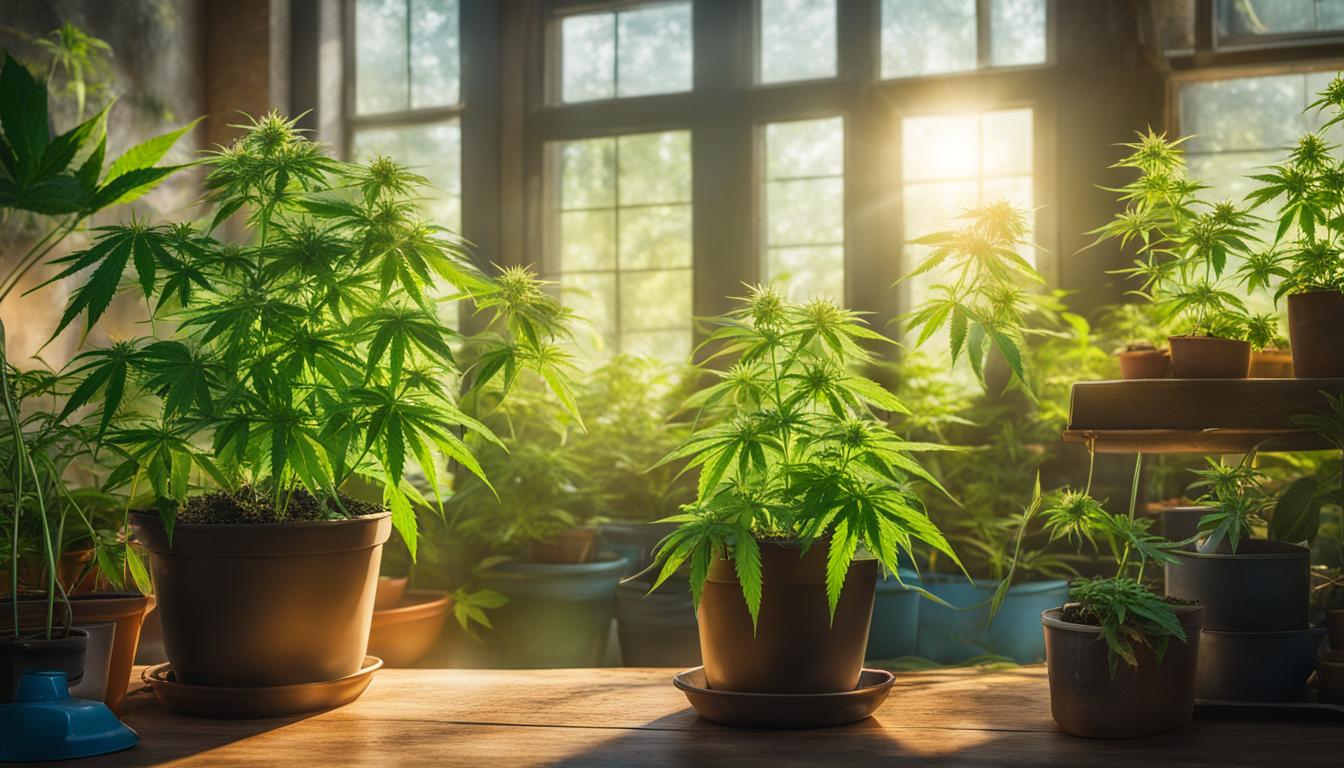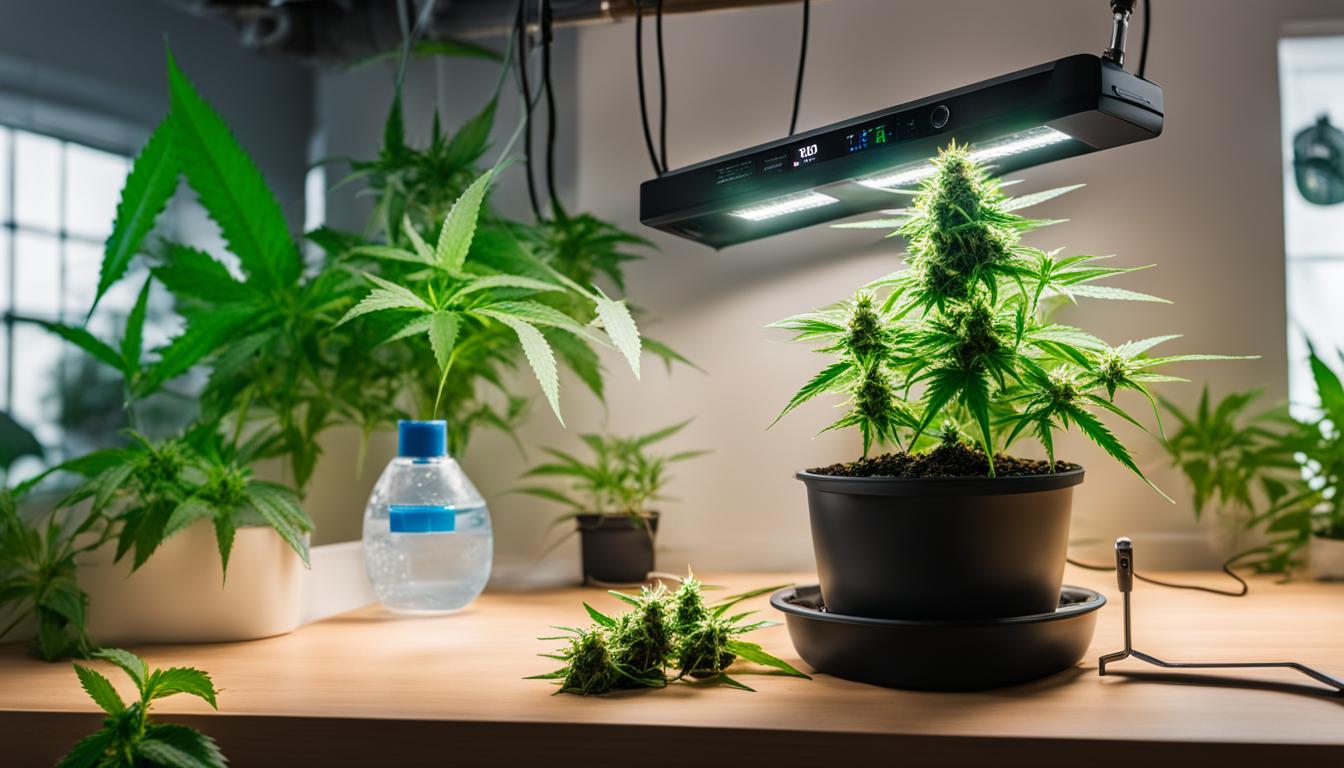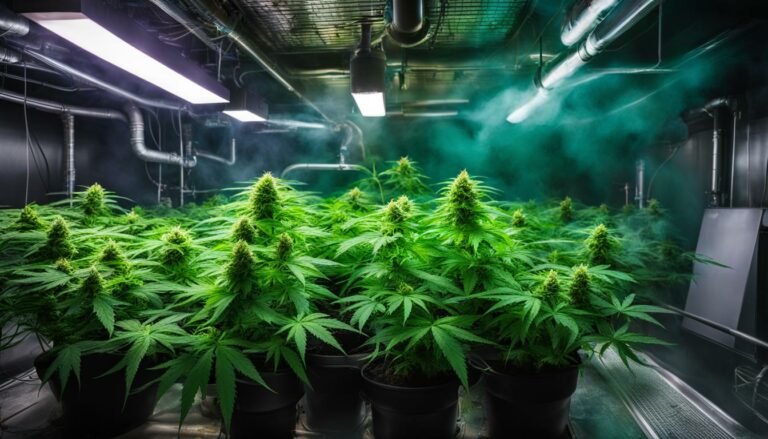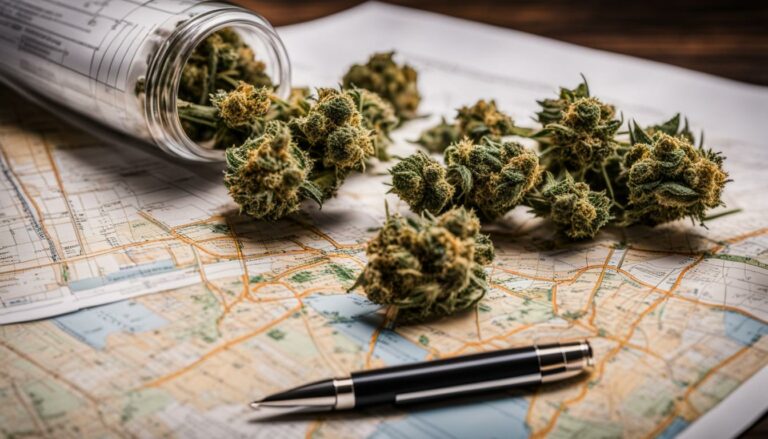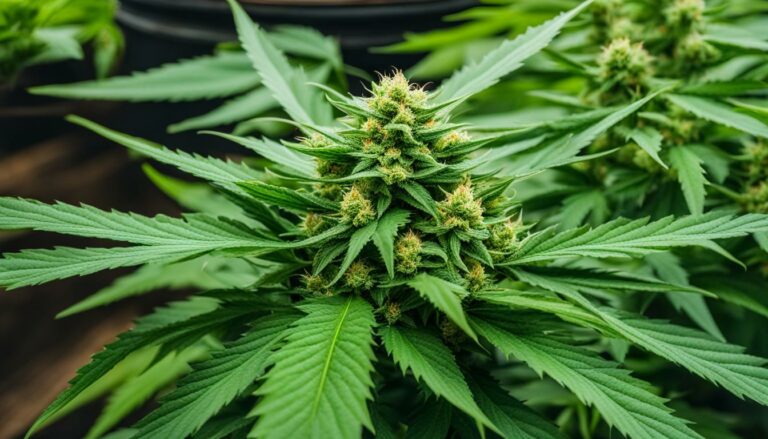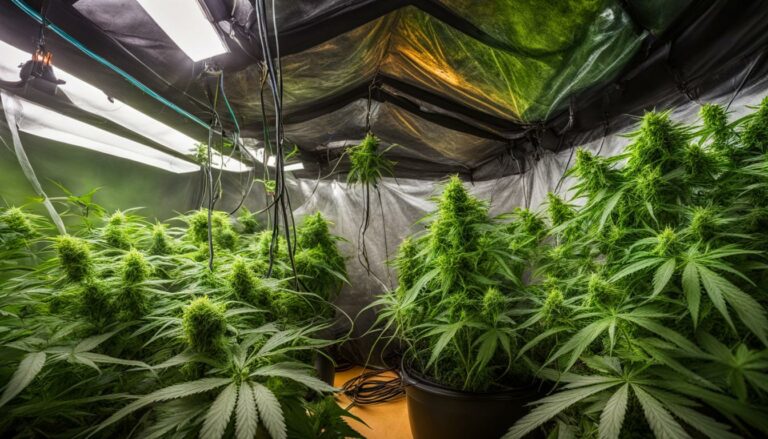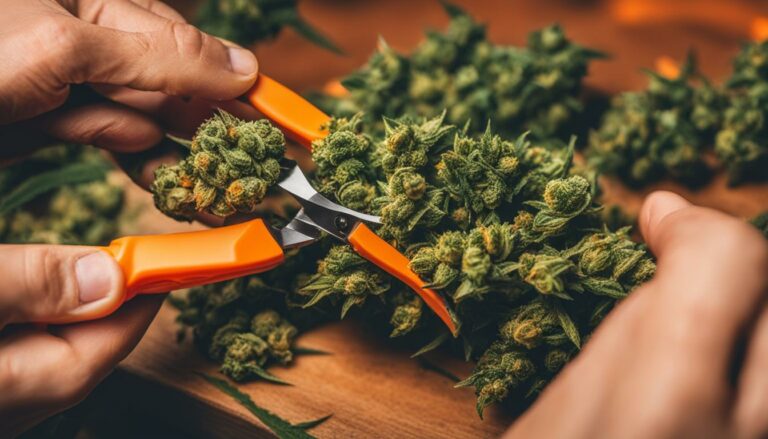The Basics of Cannabis Plant Training Techniques
Welcome to our guide on cannabis plant training techniques, where we explore the art of manipulating and enhancing the growth of cannabis plants. Whether you’re a seasoned grower or just starting your cannabis cultivation journey, understanding these plant training methods can help you achieve impressive results in terms of yields and plant structure.
Plant training is all about taking control and maximizing the potential of your cannabis plants. By employing various techniques such as topping, FIMing, supercropping, low stress training (LST), screen of green (ScrOG), removing lower branches, mainlining, and defoliation, you can shape your plants to suit your desired outcomes.
Each training technique has its own benefits and considerations, allowing you to tailor your approach to the unique requirements of your growing environment. Whether you want to increase yields, control plant height, promote bushier growth, or improve overall plant health, there’s a training method that can help you achieve your goals.
So, dive into our detailed sections to learn more about each technique and discover how you can unlock the full potential of your cannabis plants. Get ready to embrace the art of cannabis plant training and witness the transformative effects it can have on your cultivation journey.
Topping and FIMing
One of the most common cannabis plant training techniques is topping and FIMing. These methods involve strategically removing or damaging the main crown shoot of the plant to promote lateral growth and create multi-branched plants. Topping consists of cleanly cutting off the top of the main stem, while FIMing involves removing a larger portion of the top shoot. Both techniques redirect the plant’s energy away from the main cola, resulting in bushier growth and increased yields.
Topping and FIMing are effective for controlling plant height and maximizing canopy space. By removing the dominant apical meristem, which is responsible for apical dominance (the promotion of single cola growth), the plant’s growth hormones are redistributed to the lateral branches. This encourages the development of multiple main colas, allowing for a more even distribution of buds and improved overall yield.
When topping or FIMing, it’s important to use clean tools to prevent the introduction of any pathogens. Additionally, growers should choose the appropriate time to perform these techniques, typically during the vegetative stage when the plant has fully established its root system. Careful observation and practice are key to mastering these techniques and achieving desired results.
Topping and FIMing Techniques
| Technique | Description |
|---|---|
| Topping | Removing the top of the main stem to encourage lateral growth and create multiple main colas. |
| FIMing | Removing a larger portion of the top shoot to promote bushier growth and increase yields. |
By utilizing topping and FIMing techniques, cannabis growers can harness the natural vigor and potential of their plants. These methods provide a means of manipulating plant growth, resulting in multi-branched plants with increased bud sites and improved yields. With careful practice and experimentation, growers can master these techniques and unlock the true potential of their cannabis plants.
Supercropping: Enhancing Cannabis Growth through High-Stress Training
Cannabis cultivation enthusiasts are continually exploring innovative techniques to maximize their plant’s potential. One such technique gaining popularity is supercropping, a high-stress training method that involves bending and breaking the inner part of a cannabis stem. By subjecting the plant to controlled stress, supercropping redirects its energy towards lower branches, resulting in increased vigor and growth.
Supercropping is an art form that requires careful precision and expertise. Growers carefully select the stem to be manipulated and gently bend it until it cracks or snaps, without completely severing it. This process creates a swollen area around the damaged tissue, providing support and enabling increased nutrient transport to the affected areas. As a result, the plant adapts, producing thicker stems and developing more robust branches.
The benefits of supercropping extend beyond increased vigor. By manipulating the plant’s structure, growers can effectively control the height and shape of their cannabis plants. Supercropping also allows for better light penetration and air circulation, reducing the risk of common issues such as mold and mildew. Furthermore, by encouraging lateral growth, this technique promotes the development of multiple flowering sites, ultimately leading to higher yields.
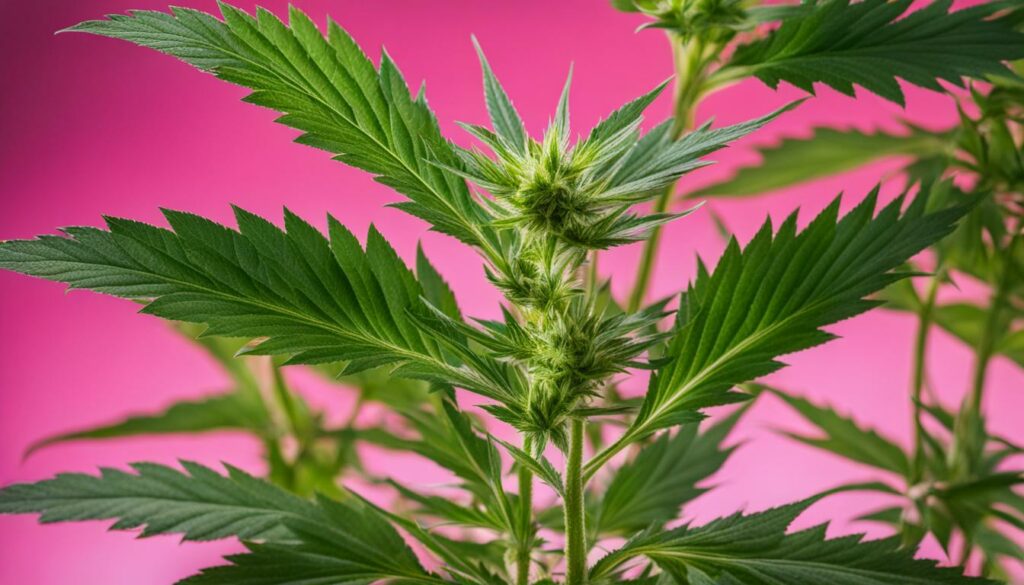
Bolstering Cannabinoid Production
In addition to enhanced growth, supercropping can also influence cannabinoid production in cannabis plants. By strategically applying stress to specific areas, growers can manipulate the plant’s natural defense mechanisms, prompting it to produce higher levels of beneficial compounds such as cannabinoids and terpenes. This technique allows growers to tailor their cannabis to specific preferences and desired effects.
Supercropping has revolutionized my cannabis cultivation journey. Not only have I witnessed increased growth and stronger stems, but the overall quality and potency of my harvests have also improved significantly. It’s a technique that requires patience and precision, but the results are undoubtedly worth it. – Experienced cannabis grower
As with any training technique, it is crucial to exercise caution and perform supercropping during the vegetative stage when plants have the ability to recover from stress more efficiently. Careful observation and monitoring of the plants’ response are essential to avoid causing irreparable harm. By mastering the art of supercropping, growers can harness the plant’s resilience and sculpt their cannabis into a masterpiece of strength, yielding impressive results.
Low Stress Training (LST)
Low stress training (LST) is a popular cannabis plant training technique that focuses on bending and securing the stems of the plants to maximize light exposure. By gently manipulating the branches and tying them down in a horizontal position, LST allows for an even distribution of light throughout the entire plant, promoting healthy growth and development.
By bending and securing the stems, LST encourages the lower branches to grow upwards towards the light source. This technique helps create a more symmetrical canopy and prevents the lower branches from becoming overshadowed by the top growth. The result is a bushier plant with multiple bud sites, leading to increased yields and higher-quality flowers.
The main advantage of low stress training is its non-invasive nature. Unlike high-stress techniques like topping or supercropping, LST does not involve damaging or removing any part of the plant. This makes LST a beginner-friendly method that can be easily mastered by growers of all experience levels. Whether you’re growing in a small indoor tent or a large outdoor garden, LST can be adapted to suit different setups and plant sizes, making it a versatile and effective training technique.
Benefits of Low Stress Training:
- Maximizes light exposure to all parts of the plant
- Promotes even canopy development
- Encourages bushier growth and multiple bud sites
- Increases yields and improves flower quality
Tips for Low Stress Training:
- Start training early in the vegetative stage when the stems are still flexible.
- Use soft materials such as plant ties or soft wire to avoid damaging the branches.
- Regularly adjust and secure the ties as the plant grows to maintain the desired shape.
- Monitor the plant closely to ensure that the ties are not causing any damage or restricting growth.
Low stress training is an effective technique for maximizing light exposure and promoting bushier growth in cannabis plants. By bending and securing the stems, growers can create a more symmetrical canopy and increase the number of bud sites, ultimately leading to higher yields and better-quality flowers. Whether you’re a beginner or an experienced grower, LST is a versatile and non-invasive training method that can be easily adapted to suit different cultivation setups. With patience and attention to detail, low stress training can help you achieve impressive results in your cannabis garden.
| Benefits of LST | Bushier Growth | Increased Yields | Improved Flower Quality |
|---|---|---|---|
| Maximizes light exposure to all parts of the plant | Promotes even canopy development | Encourages bushier growth and multiple bud sites | Increases yields and improves flower quality |
Screen of Green (ScrOG) Technique for Symmetrical Flowering Sites
The Screen of Green (ScrOG) technique is a popular method used by cannabis growers to create symmetrical flowering sites and maximize yields. This technique involves using screens or nets to create a trellis above the lower part of the plant, allowing the top branches to grow through the screen while clearing away the lower foliage. By training the plant to grow horizontally and manipulating its growth pattern, ScrOG promotes an even canopy and ensures that all buds receive ample light and nutrients, resulting in uniform bud development and increased harvest.
“The ScrOG technique is like creating a green canvas for your cannabis plants. By guiding the growth pattern and positioning the branches through the screen, you can create a beautiful and efficient garden,” explains experienced cannabis cultivator.
Using screens or nets for ScrOG allows growers to increase the number of flowering sites and improve bud density. The screen acts as a support structure for the branches, preventing them from falling over under the weight of the developing buds. Additionally, ScrOG helps to control plant height and create a more manageable and compact garden space. Whether using chicken wire, bamboo shoots, or other materials, it is important to position the screen at the right height to ensure optimal light penetration and coverage.
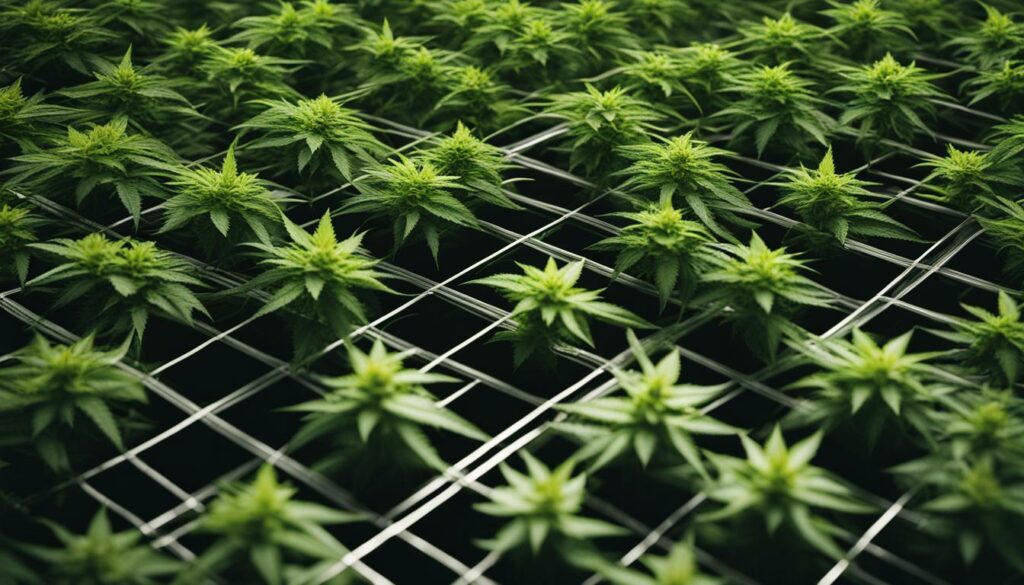
ScrOG Technique Benefits:
- Promotes symmetrical flowering sites
- Maximizes light exposure and nutrient distribution
- Increases bud density and overall yield
- Controls plant height and creates a more compact garden
- Improves air circulation and reduces the risk of mold and pests
Implementing the ScrOG technique requires careful training and maintenance throughout the vegetative and flowering stages. Regular pruning and tucking of branches are necessary to keep the canopy level and ensure that all buds receive equal light. It is important to monitor the plants closely and make adjustments as needed to maintain an optimal screen of green. With proper technique and attention to detail, the ScrOG method can greatly enhance the quality and quantity of cannabis harvests.
| Technique | Benefits |
|---|---|
| Screen of Green (ScrOG) | Promotes symmetrical flowering sites, maximizes light exposure and nutrient distribution, increases bud density and overall yield, controls plant height and creates a more compact garden, improves air circulation and reduces the risk of mold and pests |
Removing Lower Branches
In the process of pruning cannabis plants, one technique that growers often employ is the removal of lower branches. This technique is commonly referred to as the “lollipop effect” due to the resulting appearance of the plant, with a bare stem and a dense canopy of foliage at the top. By selectively removing the lower branches, growers can redirect the plant’s energy towards the upper buds, ultimately resulting in larger and more potent flowers.
Removing fan leaves also plays a crucial role in this process. By strategically removing certain fan leaves, growers can improve air circulation within the plant canopy, reducing the risk of pests and diseases. Additionally, removing fan leaves can enhance light penetration, ensuring that the upper buds receive optimal light exposure for maximum growth and development.
It is important to note that pruning should be done at the proper time to avoid inhibiting the plant’s growth. Removing lower branches and fan leaves should typically be carried out during the flowering stage, as this is when the plant’s energy is primarily focused on bud production. Care should be taken to avoid excessive pruning, as this can negatively impact the plant’s overall health and yield.
Benefits of Removing Lower Branches:
- Redirects the plant’s energy towards upper buds
- Results in larger and more potent flowers
- Improves air circulation within the plant canopy
- Reduces the risk of pests and diseases
- Enhances light penetration for optimal growth
Pruning and removing lower branches is a key technique in cannabis cultivation that can significantly improve the quality and yield of the final harvest. By strategically removing excess foliage and redirecting the plant’s energy towards the upper buds, growers can achieve impressive results and maximize the potential of their cannabis plants.
Overall, the removal of lower branches and fan leaves is an essential aspect of cannabis plant training that allows growers to shape and optimize plant growth. By implementing this technique, growers can create a well-structured plant with improved air flow, reduced risk of pests and diseases, and enhanced bud development. It is an effective method for maximizing the quality and quantity of the final harvest.
Table: Comparing the Effects of Removing Lower Branches
| Effects | Benefits |
|---|---|
| Redirected energy | Promotes larger and more potent flowers |
| Improved air circulation | Reduces the risk of pests and diseases |
| Enhanced light penetration | Optimizes growth and development of upper buds |
By removing lower branches and fan leaves, growers can actively shape the growth and development of their cannabis plants, resulting in improved air flow, reduced risk of pests and diseases, and enhanced bud production. It is a technique that should be implemented with care and consideration, ensuring that pruning is done at the appropriate time to maximize the plant’s overall potential.

Mainlining: Achieving Symmetrical Plant Growth and Multiple Main Colas
When it comes to maximizing cannabis plant growth and achieving impressive yields, mainlining is a technique that deserves attention. By focusing on creating symmetrical plant growth and multiple main colas, mainlining can help cannabis growers optimize their cultivation efforts. This advanced training technique requires patience and careful training, but the results can be truly remarkable.
At its core, mainlining involves removing the top shoot and all lower growth of a cannabis plant, resulting in a bare stem. This strategic pruning allows two axillary shoots to grow upward from the plant’s main stem, forming two primary shoots. These primary shoots can then be tied down to create a “T” shape, ensuring that all buds receive equal light and nutrients.
The beauty of mainlining lies in its ability to create a symmetrical structure that promotes even growth throughout the plant. By encouraging multiple main colas, growers can expect to see an increase in overall bud production. Additionally, symmetrical plant growth allows for better light penetration, which can lead to larger, denser flowers.
| Mainlining Benefits | Considerations |
|---|---|
| • Symmetrical plant growth | • Requires patience and careful training |
| • Multiple main colas | • Advanced technique |
| • Increased bud production | • Requires regular maintenance |
| • Better light penetration | • Can be time-consuming |
Mainlining can be a game-changer for growers looking to achieve maximum plant potential. However, it’s important to consider the time and effort required to successfully implement this technique. Regular maintenance, including tying down the primary shoots and managing the plant’s overall structure, will be necessary throughout its growth cycle.
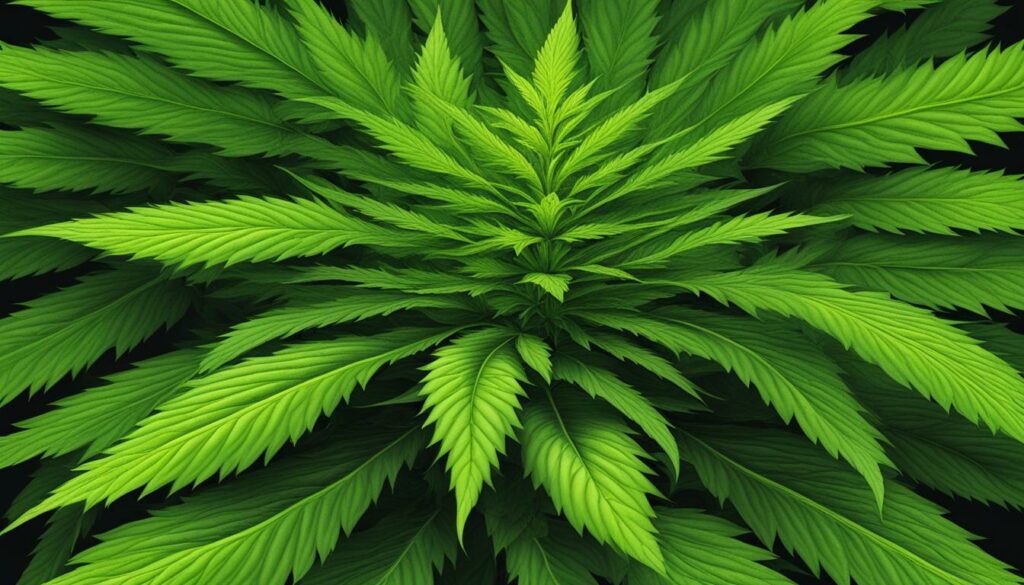
“Mainlining allows for symmetrical plant growth, multiple main colas, and increased bud production. By carefully training and shaping the plant, growers can achieve impressive yields and optimize their cannabis cultivation.”
The Power of Defoliation in Cannabis Plant Training
When it comes to maximizing the health and productivity of your cannabis plants, defoliation is an essential technique that should not be overlooked. By selectively removing fan leaves throughout the vegetative and flowering stages, growers can unlock the true potential of their plants, leading to improved flower size and enhanced bud production.
Defoliation, also known as leaf stripping, involves strategically removing leaves that are obstructing light or have become less productive. By doing so, growers can redirect the plant’s energy and resources to the upper buds, allowing them to develop into larger and denser flowers. The process of defoliation also improves air circulation within the canopy, reducing the risk of pests and diseases.

When implementing defoliation techniques, it’s important to strike the right balance. Removing too many leaves can stress the plant and inhibit its growth, while removing too few leaves may not yield the desired results. Timing is also crucial, as defoliation should be done during the appropriate stages of growth and with caution to avoid causing harm to the plant.
Benefits of Defoliation in Cannabis Plant Training
Defoliation offers several key benefits in cannabis plant training:
- Improved Flower Size: By redirecting the plant’s energy to the upper buds, defoliation stimulates their growth, resulting in larger and more robust flowers.
- Enhanced Bud Production: Removing obstructing leaves allows more light to reach the lower parts of the plant, encouraging increased bud development and overall yield.
- Air Circulation and Disease Prevention: Defoliation opens up the canopy, promoting better airflow, reducing humidity, and minimizing the risk of pests and diseases.
Incorporating defoliation into your cannabis plant training regimen can significantly improve flower quality and maximize yields. By carefully selecting which leaves to remove and when, you can optimize the growth of your plants and achieve impressive results.
Table: Defoliation Techniques and Considerations
| Technique | Considerations |
|---|---|
| Strategic Leaf Removal | – Remove fan leaves that obstruct light and air circulation – Avoid removing too many leaves at once – Perform defoliation during the vegetative and early flowering stages |
| Leaf Tucking | – Gently fold larger fan leaves to expose bud sites to more light – Ensure leaves are not folded too tightly, restricting airflow |
| Lollipopping | – Remove lower branches and leaves to focus plant energy on upper buds – Perform lollipopping during the transition from vegetative to flowering stage |
The Art of Enhancing Your Cannabis Plants
Defoliation is an art that requires careful observation, experimentation, and adaptability. By understanding the benefits and techniques of defoliation, you can unlock the full potential of your cannabis plants, promoting larger flower size, enhanced bud production, and overall plant health. With proper implementation and adherence to best practices, you can elevate your cannabis cultivation to new heights.
Conclusion
Cannabis plant training techniques provide growers with the ability to manipulate and enhance the growth of their plants, resulting in increased yields and improved plant structure. By employing methods such as topping, FIMing, supercropping, low stress training (LST), screen of green (ScrOG), removing lower branches, mainlining, and defoliation, growers can unlock the full potential of their cannabis cultivation.
Each technique offers unique benefits and considerations, allowing growers to tailor their approach to meet their specific goals and growing environment. Whether the aim is to control plant size, promote bushier growth, or maximize light exposure, cannabis plant training techniques enable growers to achieve the desired outcomes.
By harnessing the power of these techniques, growers can manipulate and enhance plant growth to increase yields and improve overall quality. The careful application of training methods allows for greater control and precision in cannabis cultivation, ultimately leading to impressive results and a rewarding cultivation experience.
So, whether you are an experienced cultivator looking to fine-tune your process or a beginner eager to learn new techniques, exploring cannabis plant training methods can take your cultivation to the next level. With increased yields and the ability to shape and optimize plant growth, these techniques offer exciting possibilities for growers seeking to achieve their full cannabis cultivation potential.
FAQ
What is cannabis plant training?
Cannabis plant training involves various techniques that can manipulate and enhance the growth of cannabis plants. These techniques aim to increase yields, control plant size, and create bushier growth.
What are some common plant training methods?
Some common plant training methods include topping, FIMing, supercropping, low stress training (LST), and using screens or nets to create a screen of green (ScrOG).
How does topping and FIMing work?
Topping and FIMing involve removing or damaging the main crown shoot of a cannabis plant. This redirects the plant’s energy to lateral growth, creating multi-branched plants and increasing the number of main colas.
What is supercropping?
Supercropping is a high-stress training technique that involves bending and breaking the inner part of a cannabis stem. By damaging the stem, the plant redirects its energy to lower branches, resulting in increased vigor and growth.
How does low stress training (LST) work?
LST techniques involve bending and securing stems in a horizontal position, encouraging lower branches to grow upwards towards the light. This helps create a more even canopy and promotes vigorous growth in lower branches.
What is the ScrOG technique?
The ScrOG technique involves using a screen or net to create a trellis for the upper canopy of cannabis plants. This promotes symmetrical flowering sites and maximizes the yield of the plant.
Why should lower branches be removed?
Removing lower branches and fan leaves can redirect the plant’s energy to upper buds, resulting in larger and more potent flowers. It also improves air flow, reduces the risk of pests and diseases, and allows for better light penetration.
How does mainlining work?
Mainlining focuses on achieving symmetrical plant growth by removing the top shoot and all lower growth. This creates a bare stem, allowing two axillary shoots to grow upward and form two primary shoots, resulting in uniform bud production.
What is defoliation?
Defoliation involves removing selected fan leaves during the vegetative and flowering stages of cannabis plants. By removing less productive or obstructing leaves, growers can redirect the plant’s energy to the upper buds, resulting in larger and denser flowers.
What are the benefits of cannabis plant training techniques?
Cannabis plant training techniques offer growers the opportunity to manipulate and enhance plant growth, resulting in increased yields and improved plant structure.


